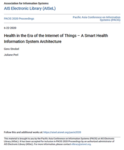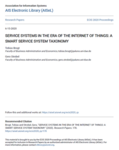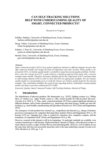SISA
Smart Information System Architecture
SISA - Smart Information System Architecture
Smart Information System Architecture (SISA)
Digitalization is advancing and spreading today, based on the technological developments of the last few years, almost all areas of professional and everyday life, leading to an irreversible fusion of the real and digital worlds. At the centre of this development is the Internet of Things (IoT) and the associated smart products that act as a link between the real and digital worlds.
Even system-relevant and formerly conservative domains such as agriculture, the energy sector, or even health care is subject to this disruptive transformation. The possible applications and the range of capabilities of IoT-based information systems are manifold. This ranges from pure monitoring to situation-adaptive remote control, to autonomous decision making based on current and historical data. McKinsey assumes that by 2023 43 billion intelligent products will be used in the most diverse domains.
In order to exploit the full potential of these systems in a value-added way, it is not enough to use individual sensors or smart products, but it is necessary to design holistic information systems from the ground up, oriented to the IoT paradigm and thus smart. To be able to take such a systemic perspective, it is essential to have a basic understanding of the individual system components, their structure and properties, as well as the interaction of these within the system.
Against this background, the goal of the research project is to develop an information system architecture for smart information systems considering the following aspects:
- Which system components are essential for IoT-based smart information systems?
- How can these system components be formalized based on their properties and structures?
- How do the individual system components interact within the system?
- What interactions and relationships exist between the individual system components?
Based on the results and publications of this research project, the SISML - Smart Information System Modelling Language project will develop a domain-specific modelling language and corresponding modelling tools.
Publikationen
- Strobel, Gero; Perl, Juliane: Health in the Era of the Internet of Things – A Smart Health Information System Architecture. In: AiS (Ed.): Proceedings of the 24th Pacific Asia Conference on Information Systems (PACIS). Dubai, UAE, 2020. AbstractDetailsFull textCitation
Health and well-being have been among the essential needs of humanity since the beginning of time. The healthcare systems are coming under more and more pressure due to a constantly growing world population, demographic change and steady rising of chronic disease rates. Through these circumstances, traditional healthcare systems may soon reach their limits and medical resources are becoming an increasingly valuable commodity. Modern technologies like the Internet of Things offer based on their application possibilities great potential for increasing among others flexibility, efficiency and cost-effectiveness of the healthcare system. To ensure such an IoT based healthcare for patients, holistic information and communication technology solutions are required that integrate both system-relevant technological and human aspects. Against this background, we present a generic information system architecture for smart health systems, based on a systematic literature driven explorative analysis of the domain.
- Brogt, Tobias; Strobel, Gero: Service Systems in the Era of the Internet of Things: A Smart Service System Taxonomy. In: AiS (Ed.): Proceedings of the 28th European Conference on Information Systems (ECIS). Marrakesh, Morocco, 2020. AbstractDetailsCitation
Services are becoming increasingly important, and service systems are seeing the use of service-dominant logic to understand value creation through the integration of active and passive resources. Digital transformation is significantly influencing service systems, and new, smart technologies are enabling innovative value propositions, leading to smart service systems. Smart products, which are a part of the Internet of Things, are the main building blocks of such systems. Attempts have been made to conceptualize smart service systems, but there seems to be no consensus in the literature because, for example, smart products have not been defined in a consistent way. We therefore examine ways to classify smart service systems in terms of their characteristics and attributes. We develop a taxonomy based on a systematic literature review focusing on smart features. Furthermore, an evaluation using domain-specific use cases demonstrates the applicability of the taxonomy. Our contribution combines and extends the available conceptualizations regarding smart service systems to pave the way for the necessary future research.
- Strobel, Gero: Agriculture in the Era of the Internet of Things: An Information System Architecture for Smart Agriculture. In: AiS (Ed.): Proceedings of the 28th European Conference on Information Systems (ECIS). Marrakesh, Morocco, 2020. AbstractDetailsCitation
Food has been a fundamental human need since the beginning of time. Agriculture, as the central foundation of global food production, is increasingly coming under pressure from the growing world population. Even today, it´s no longer possible to guarantee sufficient food security in the long term and 10% of humanity goes to bed hungry every night. Given the expected increase in the world’s population based on today’s figures and an associated more than 70% necessary increase in food sector production, the question arises whether this is feasible using classical methods and approaches. The use of modern information and communication technology alone is certainly not a panacea. Despite all this, technologies, such as the Internet of Things, show great potential for the development of more productive and cost-effective but, above all, more sustainable agriculture. However, developing such a solution requires more than a purely technical point of view. Only by creating a holistic information technology solution that takes not only a technological but also a plant, animal, human and therefore holistic perspective can real progress be made. Against this background, this paper represents the publication of a generic information system architecture based on a systematic literature-driven explorative analysis of the domain.
- Strobel, Gero: Farming in the Era of Internet of Things - An information system architecture for smart farming. In: Proceeding of the 15th International Conference on Wirtschaftsinformatik (WI). 15th Edition. Potsdam, 2020. doi:10.30844/wi_2020_x1-strobelAbstractDetailsFull textCitation
The Internet of Things and associated smart products are finding application in evermore domains. Within agriculture it is described under the term smart farming. Using smart products allows farmers to automatically record relevant information, monitor operating procedures or remotely control machines. To make these capabilities usable for added value, not only smart products but entire information systems that align to the domain and its requirements are necessary. Within the literature, various architectures can be found already. However, many lack a methodical foundation or an abstraction of application cases and technology. Against this background, the article presents an information system architecture independent of application cases or technology and oriented toward the domain of smart farming. Starting point of the development is a systematic literature review, based on Webster and Watson in combination with Vom Brocke, based on 18 existing architecture approaches that are analyzed and aggregated.
- Schiller, Barbara; Brogt, Tobias; Schuler, J. Peter M.; Strobel, Gero; Eicker, Stefan: Identifying Quality Factors for Self-Tracking Solutions: A Systematic Literature Review. In: Proceedings of the 53nd Hawaii International Conference on System Sciences. Hawaii, USA, 2020. doi:10.24251/HICSS.2020.452AbstractDetailsCitation
Self-tracking solutions have become globally widespread, as they promise numerous advantages (e.g. improving health) to their users. Despite their benefits, such solutions are often abandoned due to quality issues. This phenomenon can also be observed for digitized products in general. As self-tracking solutions are hybrid products, combining digital and physical components, traditional domain-independent and abstract quality models like the prominent ISO 25000 standard seem to not cover quality in an appropriate way. We address these issues by answering the research question of which factors affect quality perceptions of different stakeholder groups when interacting in a wearable ecosystem. We use a systematic literature review based on a research protocol to identify and analyze 98 quality-influencing factors from 19 studies that we cluster in a map. The identified factors are compared to the ISO 25000 standard, showing that certain factors like hedonic motivation are unconsidered thoroughly in the existing standard.
- Paukstadt, Ute; Strobel, Gero; Eicker, Stefan: UNDERSTANDING SERVICES IN THE ERA OF THE INTERNET OF THINGS: A SMART SERVICE TAXONOMY. In: Ais (Ed.): Proceedings of the 27th European Conference on Information Systems (ECIS). Stockholm, 2019. AbstractDetailsFull textCitation
In recent years, the “Internet of Things” with so called “smart products” has obtained increasingpopularity in both practice and research. By building on the capabilities of smart products, servicestransform to “smart services” emphasizing the value smart products can provide and how it is co- created. Even though first attempts have been conducted to conceptualize and classify smart services, there seems to be no overall consensus on the specific characteristics of smart services, which different forms they can take on and how different smart services can be described. For example, existing research on smart services does not always consider the common service design elements “servicecontent” and “service delivery”. To address this shortcoming, we develop a taxonomy of smart services by applying extant literature. We further demonstrate the usefulness of our taxonomy by classifying 50 empirical objects and presenting three cases. As a contribution, the paper enhances the understanding of the notion of smart services and strengthens the conceptual foundation for future smart service research.
- Strobel, Gero; Paukstadt, Ute; Becker, Jörg; Eicker, Stefan: Von smarten Produkten zu smarten Dienstleistungen und deren Auswirkung auf die Wertschöpfung. In: HMD Praxis der Wirtschaftsinformatik, Vol56 (2019), No 3, p. 494-513. doi:10.1365/s40702-019-00520-xAbstractDetailsFull textCitation
Im Rahmen der Digitalisierung nehmen smarte Produkte und die darauf aufbauenden intelligenten Dienstleistungen einen immer größeren Platz sowohl im betrieblichen Kontext als auch im Endkundenbereich ein. Auslöser hierfür stellt vor allem die leistungsfähigere und kostengünstigere Hardware dar, welche es Unternehmen ermöglicht, zunehmend Produkte mit intelligenten und vernetzten Komponenten auszustatten. Diese smarten Produkte bieten Unternehmen und Kunden völlig neue Möglichkeiten zur Interaktion, bieten neue Mehrwerte und beeinflussen die unternehmerische Wertschöpfung an sich. Ziel dieses Beitrages ist es, einen Einstieg in das Themenfeld der smarten Produkte und Dienstleistungen zu geben und aufzuzeigen, welche Möglichkeiten diese für den Endnutzer und für Unternehmen eröffnen.
- Paukstadt, Ute; Strobel, Gero; Eicker, Stefan; Becker, Jörg: Smart Services und ihr Einfluss auf die Wertschöpfung und Geschäftsmodelle von Unternehmen. In: Kollmann, Tobias (Ed.): Handbuch Digitale Wirtschaft. Springer Gabler, Wiesbaden, 2019, p. 1-21. doi:10.1007/978-3-658-17345-6AbstractDetailsFull textCitation
In den letzten Jahren wurde die Digitalisierung verstärkt vor dem Hintergrund desInternets der Dinge betrachtet, bei dem jegliche Bestandteile des täglichen Lebens zu intelligenten Objekten (Smart Products) werden und mit dem Internet verbunden sind. Aufbauend auf den Smart Products entstehen neue digitale Dienstleistungen, sogenannte Smart Services. Mit diesen intelligenten Dienstleis- tungen werden völlig neue Wertschöpfungspotenziale erschlossen, die sich eben- falls auf die Geschäftsmodelle von Unternehmen auswirken. Ziel dieses Beitrages ist es, einerseits einen allgemeinen Einstieg in den Themenkomplex der Smart Services zu bieten und selbige andererseits spezifisch vor dem Hintergrund ihres Wertschöpfungspotenzials für Geschäftsmodelle und Ökosysteme näher zu beleuchten.
- Schiller, Barbara; Brogt, Tobias; Schuler, J. Peter M.; Strobel, Gero: Can Self-Tracking Solutions Help with Understanding Quality of Smart, Connected Products?. In: Ais (Ed.): Proceedings of the 26th European Conference on Information Systems (ECIS). Portsmouth, 2018. AbstractDetailsCitation
Smart connected products (SCPs) have gained significant attention in different domains because they offer numerous benefits and change the way of competition and value creation. While quality is im-portant for SCPs, no holistic quality model is available to target the present quality problems. Further-more, since the concept of an SCP is quite abstract, a bottom-up approach that starts with a concrete example seems suitable. Therefore, this paper identifies the five key components of SCPs and maps them to self-tracking solutions (STS) in order to show that STSs are suitable substitutes. We also analyse quality models in corresponding areas to verify the absence of a holistic quality model for the selected example. This contribution identifies the research gap regarding holistic, stakeholder-oriented quality models and helps researchers understand SCPs better.
Ansprechpartner am Lehrstuhl










